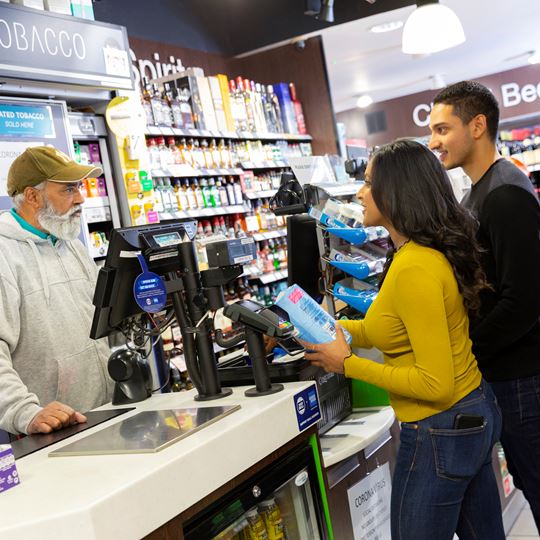Maximise Your Hair Care Product Sales Using These Proven Techniques

The market for hair care products in the UK is worth £875m. That’s a huge chunk of cash – it’s more than the dental care, washing and bathing and deodorants categories, for example. As a convenience retailer, it’s worth getting your range right, but the choice of products on offer is large and potentially confusing. So… how do you do it? Read on to learn how you can stock and merchandise the right range to sell more and attract loyal, repeat shoppers.
Hair Care is split into three sub-categories: shampoo, conditioner, and styling. Shampoo makes up 47% of the market, conditioner 33% and styling the remaining 20%1. Combined they make a pretty big subject, so today we’re focusing on shampoo and conditioner, and we’ll cover the styling segment in the next feature.
There are three types of shampoo and conditioner consumers. First, there are ‘scalp care’ shoppers, which essentially means anti-dandruff. 50% of the UK population suffer from some form of dandruff or flaky scalp2, which goes some way to explain why Head & Shoulders is not only the best-selling shampoo brand in the UK, it’s also the best-selling shampoo in the world!

The second consumer type is the ‘performance’ shopper. Essentially, these shoppers are looking for a product that does the job properly. In practice, there’s a wide interpretation of what this means, and shoppers work to different budgets. There are several ways to split these shoppers into smaller groups, but one of the most straightforward ways is into those who tend to choose higher-end products such as OGX, Charles Worthington, John Frieda and Aussie, and those who choose more mainstream performance brands such as Tresemme, L’Oreal Elvive and Pantene. The higher-end shopper can be considered ‘Salon-Inspired’, as many brands follow the trends seen in salons, and many offer a more premium experience.
The final group are the ‘naturals’ consumers. There’s a wide span of shoppers within this segment, and ‘naturals’ products range from entry-level up to premium. At the top end, some products are 100% organic and biodegradable, with 100% recycled packaging that can all be recycled again, often from carbon-neutral or carbon-negative manufacturers. Entry-level ‘naturals’ shoppers, however, are simply looking for products with scents that are inspired by nature, with a less deliberate focus on the environmental impact. Many shoppers report that they are concerned about the environment and the impact of the products they use, but with the cost-of-living crisis riding high on people’s lists of concerns, the balance between sustainability and price is an important consideration.

While this is interesting information, if you’re a Convenience store operator, how can you turn that into sales?
How many products you stock is obviously going to depend on how big your store is and how much space you have available. You will maximise your sales by covering the three need states – scalp care, performance, and naturals – with the best-selling products in each segment.
To cover the ‘scalp care’ shopper, you need Head & Shoulders. The 2-in-1 Classic Clean 225ml pack is our top recommendation because it adds a bit of extra value for the shopper – shampoo and conditioner – and it’s available as a £2.99 PMP. As an alternative, you can stock the 250ml Classic Clean shampoo instead. It sells well, but there’s no PMP. You could have both in the range together, but if you’ve got limited space then you only need one of them.
To cover the ‘performance’ shopper, the top priority is Tresemme Rich Moisture shampoo 300ml, which is a £2.50 PMP, and Pantene Repair and Protect 270ml shampoo, which is a £2.99 PMP. Both have a matching conditioner (both as PMPs), and you should always place the conditioner next to its matching shampoo on-shelf. If you’ve got more space in your range, you can extend to L’Oreal Elvive Colour Protect (250ml shampoo, 200ml conditioner), and to Aussie Miracle Moist (300ml shampoo, 200ml conditioner).
To satisfy the ‘naturals’ shopper, your priority is Alberto Balsam Raspberry 350ml, both shampoo and conditioner. It’s very well-priced at £1, and it’s available as a PMP. If you have space for more than one you can add the Coconut variant as well, which is also a £1 price mark. Your other option for naturals shoppers is Herbal Essences’ Dazzling Shine. It’s one of the UK’s most well-established and recognisable hair care brands, although it’s only available as a 400ml pack so it’s more suited to larger or more rural convenience stores that carry a larger range.

With the cost-of-living crisis biting hard for many households, it’s a good idea to include an entry-level brand in the range as well. The Enliven Fruits range is a great option – it’s a premium, good quality product with an affordable price point of around £1.49 RRP*, and there’s a hair mask available at £2.49 RRP* to go with the shampoo and conditioner, to add a bit of an extra treat.
The next DCS Insight feature will cover dry shampoo, shampoo and conditioner bars and hair styling. In the meantime, you can find everything you need to know about how to select a best-selling household, health, and beauty product range over at CoreRange.com. It’s completely free to use, it’s impartial and it’s based on all the latest market data. You can find range recommendations for small, medium, and large stores, complete with planograms and tips on how to merchandise your range effectively to boost your sales. Click here to take a look.
* Selling prices are at the sole discretion of the wholesaler and retailer.
Sources:
1: Nielsen – Wash & Care, Styling – Total Market & Impulse – Value Sales – MAT: 25.02.2023
2: Proprietary brand manufacturer research (Procter & Gamble)
